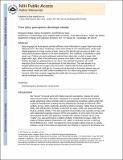| dc.contributor.author | Balas, Benjamin | |
| dc.contributor.author | Kanwisher, Nancy | |
| dc.contributor.author | Saxe, Rebecca R. | |
| dc.date.accessioned | 2016-04-08T17:10:09Z | |
| dc.date.available | 2016-04-08T17:10:09Z | |
| dc.date.issued | 2012-03 | |
| dc.date.submitted | 2012-01 | |
| dc.identifier.issn | 00220965 | |
| dc.identifier.uri | http://hdl.handle.net/1721.1/102226 | |
| dc.description.abstract | Body language and facial gesture provide sufficient visual information to support high-level social inferences from “thin slices” of behavior. Given short movies of nonverbal behavior, adults make reliable judgments in a large number of tasks. Here we find that the high precision of adults’ nonverbal social perception depends on the slow development, over childhood, of sensitivity to subtle visual cues. Children and adult participants watched short silent clips in which a target child played with Lego blocks either in the (off-screen) presence of an adult or alone. Participants judged whether the target was playing alone or not; that is, they detected the presence of a social interaction (from the behavior of one participant in that interaction). This task allowed us to compare performance across ages with the true answer. Children did not reach adult levels of performance on this task until 9 or 10 years of age, and we observed an interaction between age and video reversal. Adults and older children benefitted from the videos being played in temporal sequence, rather than reversed, suggesting that adults (but not young children) are sensitive to natural movement in social interactions. | en_US |
| dc.description.sponsorship | Ellison Medical Foundation | en_US |
| dc.description.sponsorship | National Institutes of Health (U.S.). National Center for Research Resources (COBRE Grant P20 RR020151) | en_US |
| dc.language.iso | en_US | |
| dc.publisher | Elsevier | en_US |
| dc.relation.isversionof | http://dx.doi.org/10.1016/j.jecp.2012.01.002 | en_US |
| dc.rights | Creative Commons Attribution-Noncommercial-NoDerivatives | en_US |
| dc.rights.uri | http://creativecommons.org/licenses/by-nc-nd/4.0/ | en_US |
| dc.source | PMC | en_US |
| dc.title | Thin-slice perception develops slowly | en_US |
| dc.type | Article | en_US |
| dc.identifier.citation | Balas, Benjamin, Nancy Kanwisher, and Rebecca Saxe. “Thin-Slice Perception Develops Slowly.” Journal of Experimental Child Psychology 112, no. 2 (June 2012): 257–264. | en_US |
| dc.contributor.department | Massachusetts Institute of Technology. Department of Brain and Cognitive Sciences | en_US |
| dc.contributor.mitauthor | Balas, Benjamin | en_US |
| dc.contributor.mitauthor | Kanwisher, Nancy | en_US |
| dc.contributor.mitauthor | Saxe, Rebecca R. | en_US |
| dc.relation.journal | Journal of Experimental Child Psychology | en_US |
| dc.eprint.version | Author's final manuscript | en_US |
| dc.type.uri | http://purl.org/eprint/type/JournalArticle | en_US |
| eprint.status | http://purl.org/eprint/status/PeerReviewed | en_US |
| dspace.orderedauthors | Balas, Benjamin; Kanwisher, Nancy; Saxe, Rebecca | en_US |
| dc.identifier.orcid | https://orcid.org/0000-0003-2377-1791 | |
| dc.identifier.orcid | https://orcid.org/0000-0003-3853-7885 | |
| mit.license | PUBLISHER_CC | en_US |
| mit.metadata.status | Complete | |
